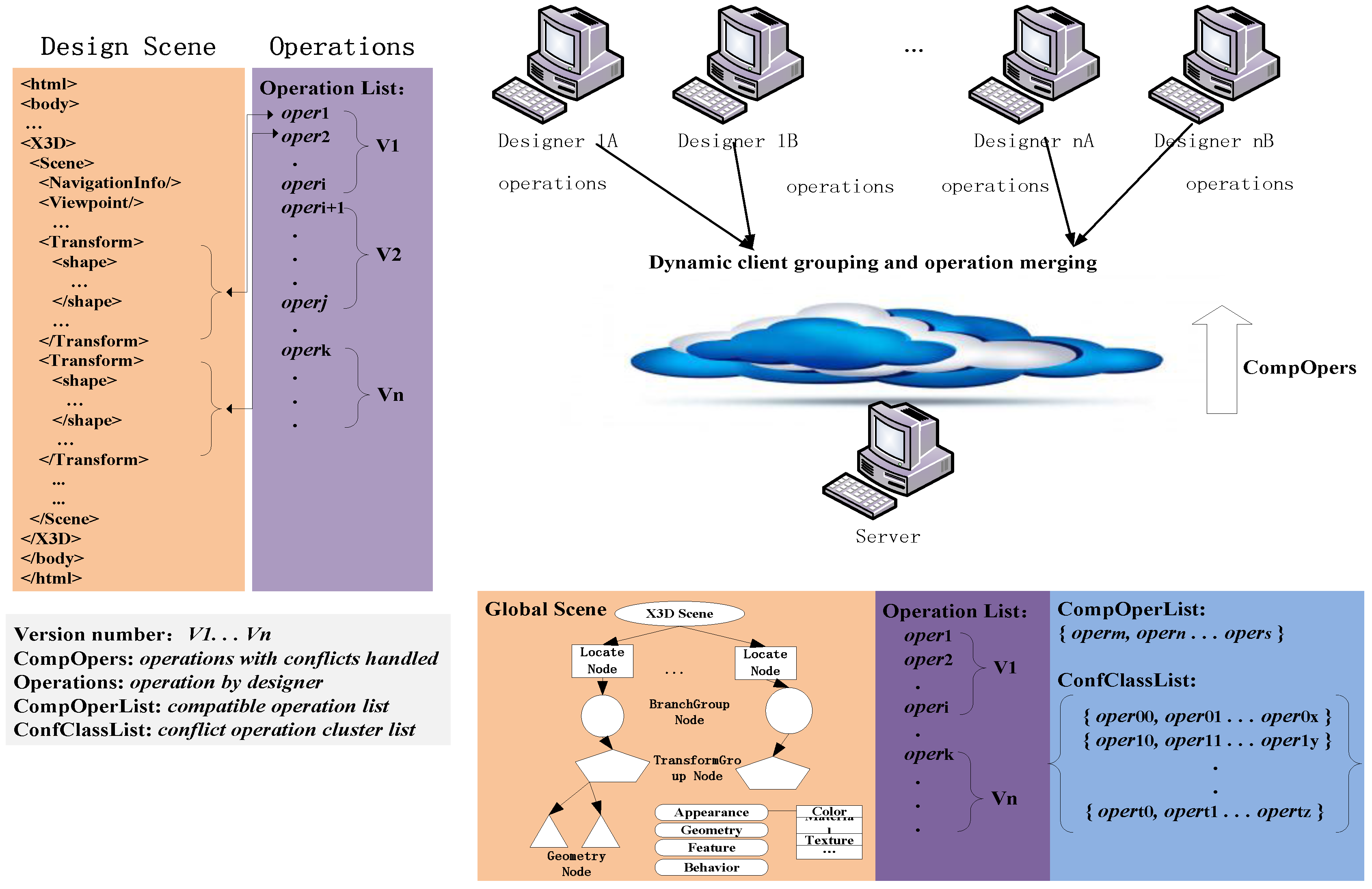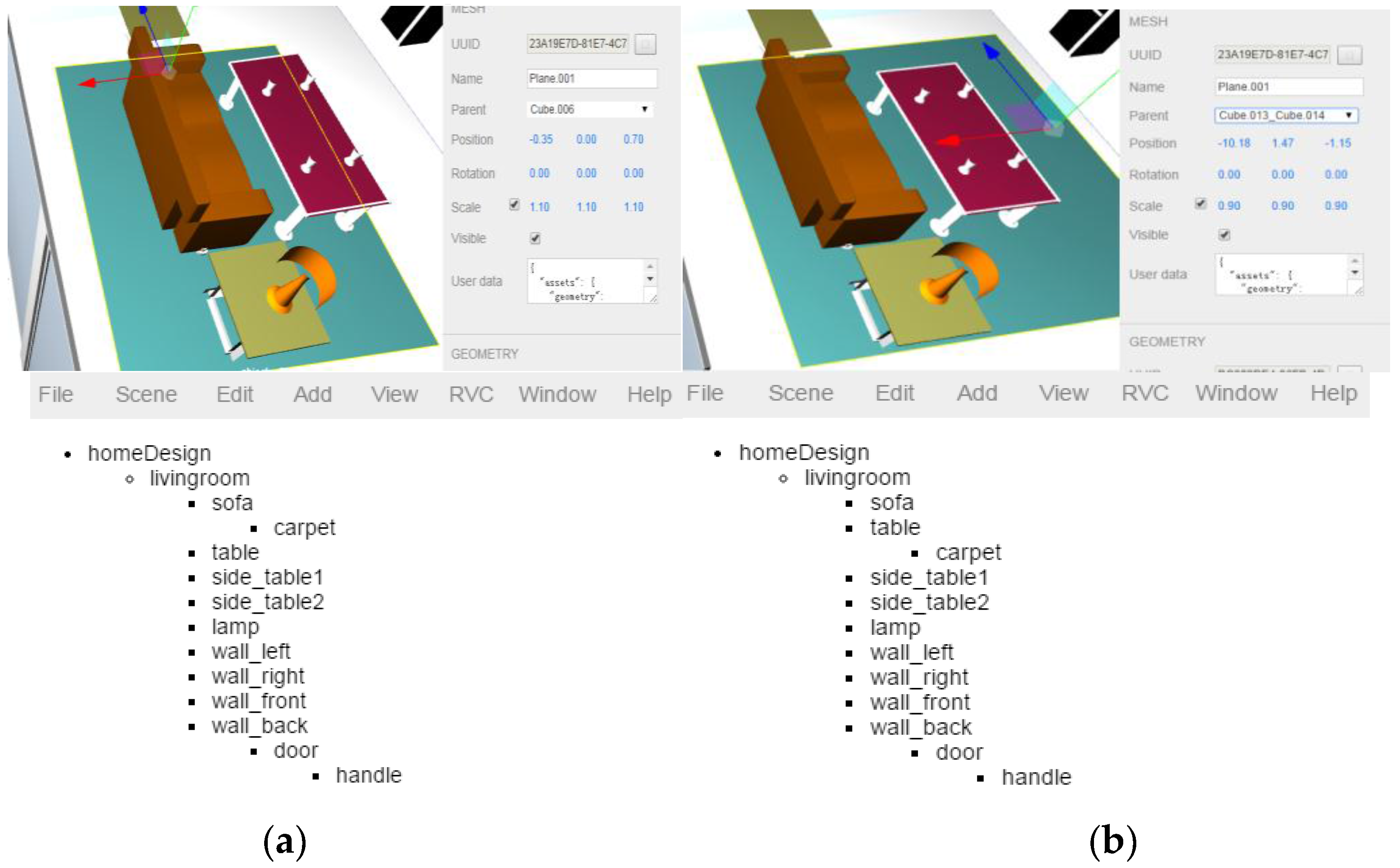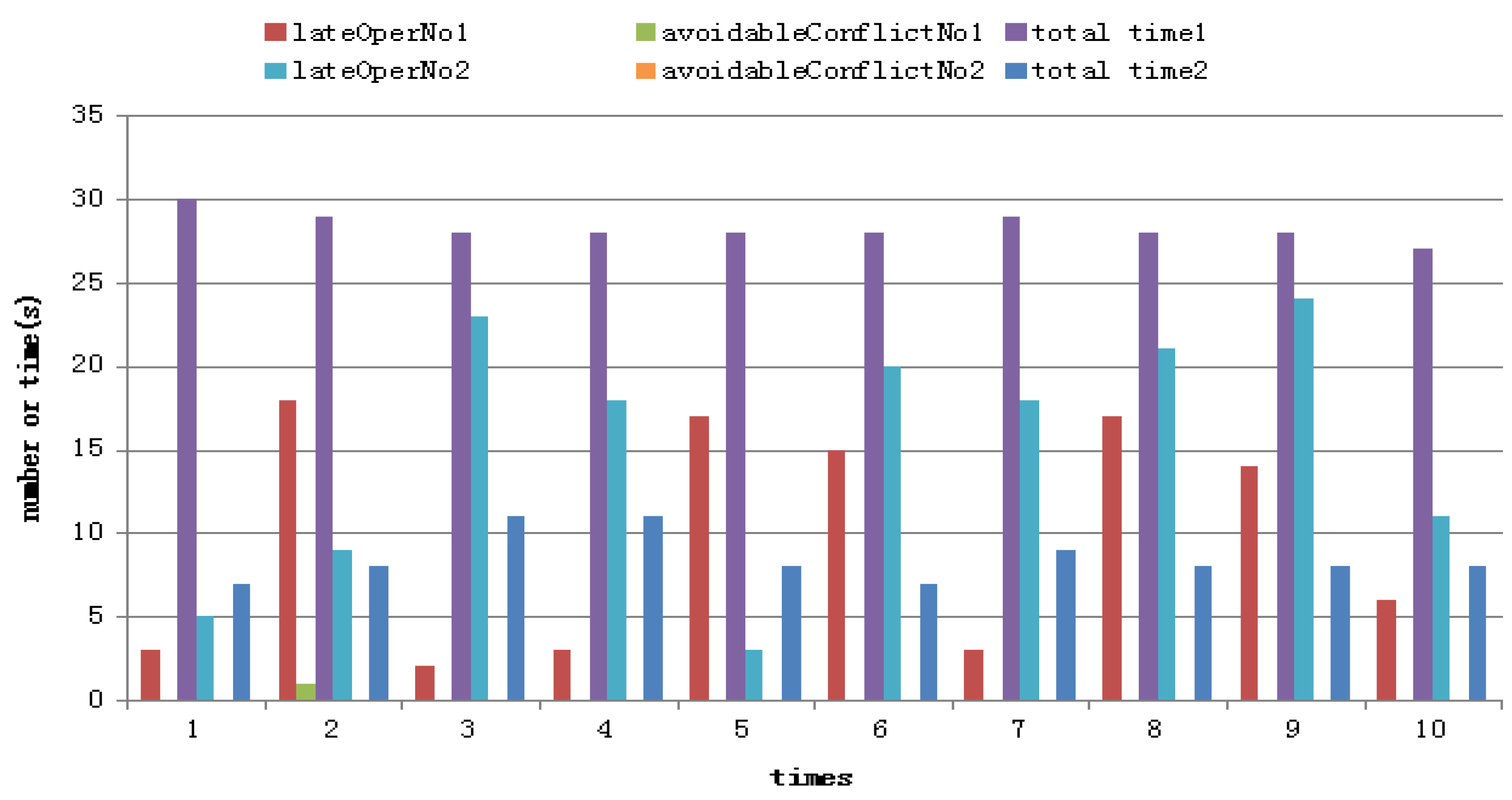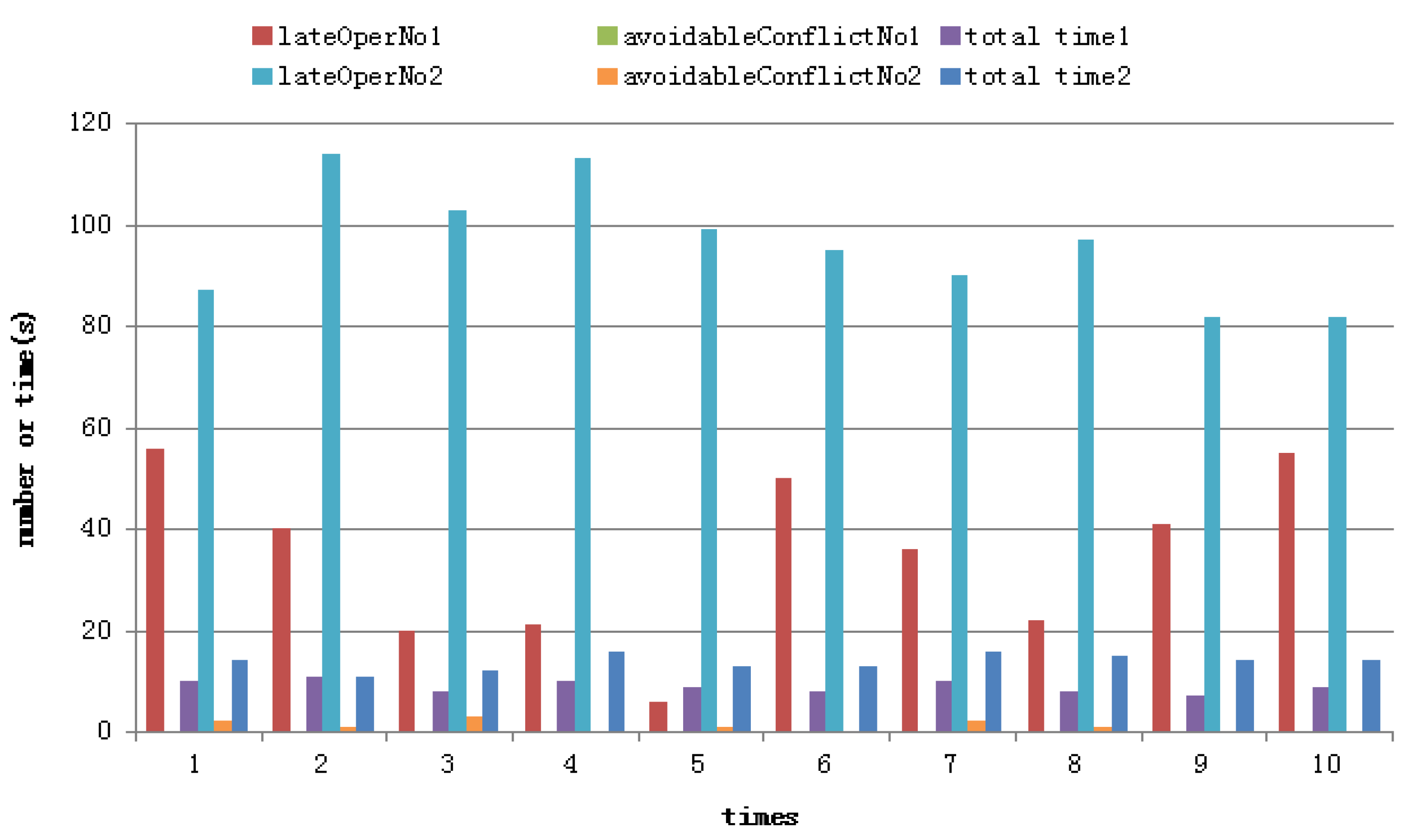Symmetry-Based Conflict Detection and Resolution Method towards Web3D-based Collaborative Design
Abstract
:1. Introduction
2. Related Work
3. A Framework of Conflict Detection and Resolution in Web-based Collaborative Design
4. Basic Conceptions and Conflict Detection
4.1. Design Resource Representation Based on X3D
4.2. Operation Description
4.3. Conflict Detection Based on Symmetry Operation Comparison
5. Multiply Strategies for Conflict Resolution
5.1. Conflict Resolution Method
5.2. Parameter Strategy
5.3. Time Strategy
5.4. Leak Filling
6. Analysis and Evaluation
6.1. System Implementation and Case Study
6.2. Evaluation
6.3. Discussion
6.3.1. Extensibility
6.3.2. Interactivity and Efficiency
7. Conclusions
Acknowledgments
Author Contributions
Conflicts of Interest
References
- Modi, C.; Patel, D.; Borisaniya, B.; Patel, H.; Patel, A.; Rajarajan, M. A survey of intrusion detection techniques in cloud. J. Netw. Comput. Appl. 2013, 36, 42–57. [Google Scholar] [CrossRef]
- Patel, A.; Taghavi, M.; Bakhtiyari, K.; Celestino Júnior, J. An intrusion detection and prevention system in cloud computing: A systematic review. J. Netw. Comput. Appl. 2013, 36, 25–41. [Google Scholar] [CrossRef]
- Spaeth, A.D.; Black, R.S. Google docs as a form of collaborative learning. J. Chem. Educ. 2012, 89, 1078–1079. [Google Scholar] [CrossRef]
- Behles, J. The use of online collaborative writing tools by technical communication practitioners and students. Tech. Commun. 2013, 60, 28–44. [Google Scholar]
- Leung, C.; Salga, A. Enabling webgl. In Proceedings of the 19th International Conference on World Wide Web, Raleigh, NC, USA, 26–27 April 2010.
- Tarukawa, K.; Inoue, T.; Okada, K. Multi-view is useful for more accurate understanding of object in a virtual soccer field. In Proceedings of the 17th IEEE International Conference on Computer Supported Cooperative Work in Design (CSCWD), Whistler, BC, Canada, 27–29 June 2013.
- Ma, X.; Cai, H.; Jiang, L. A creative approach to conflict detection in web-based 3D cooperative design. In Cooperative Design, Visualization, and Engineering; Springer: Basel, Switzerland, 2014; pp. 261–268. [Google Scholar]
- Beunza, J.-J. Conflict resolution techniques applied to interprofessional collaborative practice. J. Interprof. Care 2013, 27, 110–112. [Google Scholar] [CrossRef] [PubMed]
- Guimarães, M.L.; Silva, A.R. Improving early detection of software merge conflicts. In Proceedings of the 34th International Conference on Software Engineering, Zurich, Switzerland, 2–9 June 2012.
- Koegel, M.; Helming, J.; Seyboth, S. Operation-based conflict detection and resolution. In Proceedings of the 2009 ICSE Workshop on Comparison and Versioning of Software Models, Vancouver, BC, Canada, 17 May 2009.
- Koegel, M.; Herrmannsdoerfer, M.; von Wesendonk, O.; Helming, J. Operation-based conflict detection. In Proceedings of the 1st International Workshop on Model Comparison in Practice, Malaga, Spain, 1 July 2010.
- Cai, X.; Li, X.; He, F.; Han, S.; Chen, X. Flexible Concurrency control for legacy CAD to construct collaborative CAD environment. J. Adv. Mech. Des. Syst. Manuf. 2012, 6, 324–339. [Google Scholar] [CrossRef]
- Estler, H.C.; Nordio, M.; Furia, C.A.; Meyer, B. Unifying configuration management with merge conflict detection and awareness systems. In Proceedings of the 22nd Australasian Conference on Software Engineering (ASWEC), Melbourne, Australia, 4–7 June 2013.
- Alonso-Ayuso, A.; Escudero, L.F.; Olaso, P.; Pizarro, C. Conflict avoidance: 0–1 linear models for conflict detection & resolution. Top 2011, 21, 485–504. [Google Scholar]
- Karimadini, M.; Lin, H. Synchronized task decomposition for two cooperative agent. In Proceedings of the IEEE Conference on Robotics Automation and Mechatronics (RAM), Singapore, 28–30 June 2010.
- Lincke, J.; Krahn, R.; Ingalls, D.; Röder, M.; Hirschfeld, R. The lively partsbin—A cloud-based repository for collaborative development of active web content, System Science (HICSS). In Proceedings of the 45th Hawaii International Conference, Maui, HI, USA, 4–7 January 2012.
- Jing, S.-X.; He, F.-Z.; Han, S.-H.; Cai, X.-T.; Liu, H.-J. A method for topological entity correspondence in a replicated collaborative CAD system. Comput. Ind. 2009, 60, 467–475. [Google Scholar] [CrossRef]
- Cai, X.T.; Li, W.D.; He, F.Z.; Li, X.X. Customized Encryption of Computer Aided Design Models for Collaboration in Cloud Manufacturing Environment. J. Manuf. Sci. Eng. Trans. ASME 2015, 137, 1–10. [Google Scholar] [CrossRef]
- Baldwin, C.; von Hippel, E. Modeling a paradigm shift: From producer innovation to user and open collaborative innovation. Organ. Sci. 2011, 22, 1399–1417. [Google Scholar] [CrossRef] [Green Version]
- Chellali, A.; Jourdan, F.; Dumas, C. VR4D: An immersive and collaborative experience to improve the interior design process. In Proceedings of the 5th Joint Virtual Reality Conference of EGVE and EuroVR, JVRC, Paris, France, 11–13 December 2013.
- Juntunen, T.; Kostakos, V.; Perttunen, M.; Ferreira, D. Web tool for traffic engineers: Direct manipulation and visualization of vehicular traffic using google maps. In Proceedings of the 16th International Academic MindTrek Conference, Tampere, Finland, 3–5 October 2012.
- Sun, H.; Fan, W.; Shen, W.; Xiao, T. Ontology fusion in high-level-architecture-based collaborative engineering environments. IEEE Trans. Syst. Man Cybern. Syst. 2013, 43, 2–13. [Google Scholar] [CrossRef]
- Hepworth, A.; Staves, D.; Hill, L.; Tew, K.; Jensen, C.G.; Red, W.E. Enhancements for improved topological entity identification performance in multi-user CAD. Comput. Aided Des. Appl. 2015, 12, 1–12. [Google Scholar] [CrossRef]
- Turrin, M.; von Buelow, P.; Stouffs, R. Design explorations of performance driven geometry in architectural design using parametric modeling and genetic algorithms. Adv. Eng. Inform. 2011, 25, 656–675. [Google Scholar] [CrossRef]
- Kang, J.; Park, J.; Suk, S. Design of a distributed personal information access control scheme for secure integrated payment in NFC. Symmetry 2015, 7, 935–948. [Google Scholar] [CrossRef]
- Li, D.; Li, R. An admissibility-based operational transformation framework for collaborative editing systems. Comput. Support. Coop. Work (CSCW) 2010, 19, 1–43. [Google Scholar] [CrossRef]
- Shao, B.; Li, D.; Gu, N. A sequence transformation algorithm for supporting cooperative work on mobile devices. In Proceedings of the 2010 ACM Conference on Computer Supported Cooperative Work, Savannah, GA, USA, 6–10 February 2010.
- Shao, B.; Li, D.; Lu, T.; Gu, N. An operational transformation based synchronization protocol for web 2.0 applications. In Proceedings of the ACM 2011 Conference on Computer Supported Cooperative Work, Hangzhou, China, 19–23 March 2011.
- Sun, D.; Sun, C.; Xia, S.; Shen, H. Creative conflict resolution in collaborative editing systems. In Proceedings of the ACM 2012 Conference on Computer Supported Cooperative Work, Seattle, WA, USA, 11–15 February 2012.
- Sun, C.; Xu, D. Operational transformation for dependency conflict resolution in real-time collaborative 3D design systems. In Proceedings of the ACM 2012 conference on Computer Supported Cooperative Work, Seattle, WA, USA, 11–14 February 2012.
- Oehrn, C.R.; Hanslmayr, S.; Fell, J.; Deuker, L.; Kremers, N.A.; Do Lam, A.T.; Elger, C.E.; Axmacher, N. Neural communication patterns underlying conflict detection, resolution, and adaptation. J. Neurosci. 2014, 34, 10438–10452. [Google Scholar] [CrossRef] [PubMed]
- Trappey, A.J.; Trappey, C.V.; Wu, C.-Y.; Fan, C.Y.; Lin, Y.-L. Intelligent patent recommendation system for innovative design collaboration. J. Netw. Comput. Appl. 2013, 36, 1441–1450. [Google Scholar] [CrossRef]
- Gu, N.; Kim, M.J.; Maher, M.L. Technological advancements in synchronous collaboration: The effect of 3D virtual worlds and tangible user interfaces on architectural design. Autom. Constr. 2011, 20, 270–278. [Google Scholar] [CrossRef]
- Jung, J.J. Computational reputation model based on selecting consensus choices: An empirical study on semantic wiki platform. Expert Syst. Appl. 2012, 39, 9002–9007. [Google Scholar] [CrossRef]
- Brosch, P.; Seidl, M.; Wieland, K.; Wimmer, M.; Langer, P. We can work it out: Collaborative conflict resolution in model versioning. In Ecscw 2009; Springer: Vienna, Austria, 2009; pp. 207–214. [Google Scholar]
- Ahmed-Nacer, M.; Urso, P.; Balegas, V.; Preguiça, N. Concurrency control and awareness support for multi-synchronous collaborative editing, Collaborative Computing. In Proceedings of the 9th IEEE International Conference on Collaborative Computing: Networking, Applications and Worksharing, Austin, TX, USA, 20–23 October 2013.
- Behr, J.; Eschler, P.; Jung, Y.; Zöllner, M. X3DOM: A DOM-based HTML5/X3D integration model. In Proceedings of the 14th International Conference on 3D Web Technology, Darmstadt, Germany, 16–17 June 2009.
- Holyoak, V.L.; Red, E.; Jensen, G. Effective collaboration through multi user cax by implementing new methods of product specification and management. Comput. Aided Des. Appl. 2014, 11, 560–567. [Google Scholar] [CrossRef]
- Goldman, M.; Little, G.; Miller, R.C. Real-time collaborative coding in a web ide. In Proceedings of the 24th annual ACM symposium on User interface software and technology, Santa Barbara, CA, USA, 16–19 October 2011.
- Wang, X.; Love, P.E.D.; Kim, M.J.; Wang, W. Mutual awareness in collaborative design: An augmented reality integrated telepresence system. Comput. Ind. 2014, 65, 314–324. [Google Scholar] [CrossRef]








| Type | Collaboration Mechanism | Problem resolved |
|---|---|---|
| Authority Type | Lock Mechanism | Conflict Avoidance |
| Traffic Light Mechanism | ||
| Request Application Mechanism | ||
| Right Mechanism | ||
| Floor Mechanism | ||
| Operation Transformation | Sequence Transformation | Real-time Conflict Resolution in Word Editing System |
| ABT Mechanism | ||
| 3D Operation Transformation | 3D Model Dependency Conflict Resolution | |
| Other Synchronous or Asynchronous | Semi-Synchronous | Conflict Detection or Resolution with Designer Participation |
| Conflict Awareness | ||
| Creative conflict resolution |
| Item | Description |
|---|---|
| Id | unique ID of an operation |
| scene_id | unique ID of a scene |
| user_id | unique ID of a designer |
| Type | operation type, Add or Delete, etc. |
| version_no | version the operation is based on |
| Params | added or deleted models array |
| Model | added or deleted model |
| scene_model_id | unique ID of a model in a scene |
| Name | model name |
| Style | model style |
| Trans | model position |
| Color | model color |
| Size | model size |
| Before | attribute value before modified |
| After | attribute value after modified |
| Operation Type | Add | Delete | Modify Size | Modify Position | Modify Color |
|---|---|---|---|---|---|
| Add | Compatible | Compatible | Compatible | Compatible | Compatible |
| Delete | – | Conflict | Conflict | Conflict | Conflict |
| Modify_Size | – | – | Conflict | Compatible | Compatible |
| Modify_Position | – | – | – | Conflict | Compatible |
| Modify_Color | – | – | – | – | Conflict |
| Item | Our Framework | Creative CR | 3D Operation Transformation |
|---|---|---|---|
| Resolved Problems | 3D Editing CD&CR | 2D CD&CR | 3D dependency conflict CD&CR |
| Network Requirement | Online | Online | Online/Offline |
| Redundant Operation | Much | Little | Little |
| Collaborative Design Efficiency | High | Low | High |
| Interactivity & Operation Will | High | Low | Low |
| Scalability | High | High | Low |
© 2016 by the authors; licensee MDPI, Basel, Switzerland. This article is an open access article distributed under the terms and conditions of the Creative Commons Attribution (CC-BY) license (http://creativecommons.org/licenses/by/4.0/).
Share and Cite
Yu, M.; Cai, H.; Ma, X.; Jiang, L. Symmetry-Based Conflict Detection and Resolution Method towards Web3D-based Collaborative Design. Symmetry 2016, 8, 35. https://doi.org/10.3390/sym8050035
Yu M, Cai H, Ma X, Jiang L. Symmetry-Based Conflict Detection and Resolution Method towards Web3D-based Collaborative Design. Symmetry. 2016; 8(5):35. https://doi.org/10.3390/sym8050035
Chicago/Turabian StyleYu, Mingjiu, Hongming Cai, Xiaoming Ma, and Lihong Jiang. 2016. "Symmetry-Based Conflict Detection and Resolution Method towards Web3D-based Collaborative Design" Symmetry 8, no. 5: 35. https://doi.org/10.3390/sym8050035





